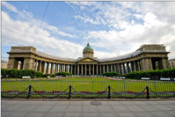
Kazan Cathedral in St. Petersburg consecrated
On September 15 (27) 1811 in St. Petersburg on the day of coronation of the Emperor Alexander I, the Kazan Cathedral was solemnly consecrated by the Metropolitan Amvrosy of Novgorod and St. Petersburg.
The Kazan Cathedral was erected in honor of a miracle-working icon of Our Lady of Kazan, discovered in the city of Kazan in 1579. Until 1710 the icon was kept in Moscow, in Theotokos Monastery of Kazan. In 1710 on the order of the Emperor Peter the Great the icon was moved to St. Petersburg into the chapel located near the Old Merchant Yard (Gostiny Dvor). On September 6 (17) 1733 on the Nevsky Prospekt (Nevksy Avenue) were laid the foundations of a stone court Church of Nativity of Theotokos. The temple was consecrated on June 13 (24) 1737 in the presence of the Empress Anna of Russia (Anna Ivanovna). A day before the consecration ceremony the icon of Our Lady of Kazan was moved to the church.
In 1799 the Emperor Paul I announced a contest for the project of a new cathedral which was intended to replace the dilapidated Church of Nativity of Theotokos. Following the contest’s indispensable condition the new cathedral was to resemble the St. Peter’s Basilica in Rome and include a grand colonnade.
The contest brought together prominent architectures of that time: P. Gonzaga, Ch. Cameron, D. Trombara, Jean Thomas de Thomon, however the Emperor approved the project suggested by a young, gifted and little-known architecture Andrei Voronikhin.
The laying of the foundation stone of the cathedral took place on August 27 (September 8) in 1801. The ceremony was attended by the Emperor Alexander I, who newly ascended to the throne. On the day of his coronation, on September 15 (27) 1811, the cathedral was consecrated.
The Kazan Cathedral was being built for 10 years and at that time was considered the largest temple in St. Petersburg. By the design the cathedral has the shape of the Latin cross. Following the tradition its sanctuary is pointing to the east. The northern facade of the cathedral with a great adjoining colonnade consisting 96 columns of Corinthian order, faces the Nevsky Prospekt. Columns, carved from enormous granite monoliths, were placed in four rows, each about 13 m in height and up to 30 tons in weight. The portico in the middle of this colonnade is decorated with the bronze figures of John the Baptist, Saint Andrew the Apostle, Saint Vladimir of Kiev and Alexander Nevsky. The cathedral has an oval dome with a gilded cross on top. It reaches 72,5 m in length, about 56,7 m in width, and 71,5 m in height. The length of each of the colonnade’s wings is 42,7 m.
The plan of Voronikhin was not implemented completely. The southern colonnade was not built, neither the exterior sculpture decoration nor the interior decoration of the cathedral was finished.
“The construction of the cathedral cost 4 million 200 thousand rubles in bank notes. When the newly-erected cathedral was consecrated and the wonder-working icon of Our Lady of Kazan was moved there, the former Church of Nativity of Theotokos in the Kazan Square, built in the time of Anna of Russia, was dismantled”.
The cathedral’s consecration was “… a real feast of the Russian architecture: both the cathedral was erected to the design and under the control of the Russian artist of natural gifts, as well as the material for its construction was taken from the depths of the Russian lands, and prepared by Russian masters in Russian plants”. Not a single foreign master participated in the construction of the Kazan Cathedral. The team of masons was headed by Samson Sukhanov. For the decoration of the cathedral were used Olonets marble, Vyborg and Serdobol granite, and Riga limestone. It was Voronikhin who for the first time in the construction practice implemented a metallic construction of the dome.
After the end of the Patriotic War of 1812 the Kazan Cathedral became the pantheon of glory of Russian Arms. Here was buried the field marshal M.I. Kutuzov; trophies of the Patriotic War and foreign campaigns of 1813-1815 were placed in the cathedral: 107 banners and standards of the Army of Napoleon, keys to 8 fortresses and 17 cities, and also a baton which belonged to the Marshal Davout. In the square in front of the Kazan Cathedral in 1837 by the model of the sculptor B. Orlovsky were erected monuments to M.I. Kutuzov and M.B. Barclay de Tolly.
After the 1917 Revolution the interior of the cathedral was changed dramatically when in 1922 church values were removed. On January 25 1932 the cathedral was closed, and on November 15 1932 in the building was opened the Museum of History of Religion and Atheism. In 1950-1956 the interior of the cathedral was being renovated, whereas its facades were being reconstructed within 1963-1968. On May 25 1991 divine services were resumed in the left chapel. The following year the main chapel was consecrated. On April 30 1994 a cross was placed on the cathedral’s dome.
In 1998 the Kazan cathedral was again consecrated, and on the order of Patriarch Alexy II of Moscow of December 31 2000 the church achieved the status of cathedral, and it became the major temple of St. Petersburg diocese of the Russian Orthodox Church.
Lit.: Аплаксин А. П. Казанский собор. СПб., 1911; Война и Казанский собор. Пг., 1915; История строительства [Электронный ресурс] // Казанский собор. Б. д. URL: http://kazansky-spb.ru/texts/stroitelstvo; Казанский собор. СПб., 2001; Лукомский Г. К. Решётка Казанского собора. Пг., 1915; Шурыгин Я. И. Казанский собор. Л., 1961.
Based on the Presidential Library’s materials:
Русские самородки в жизнеописаниях и изображениях. СПб., 1910. Вып. 6.

